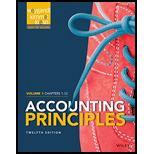
Concept explainers
(a)
Perpetual Inventory System: Perpetual Inventory System refers to the inventory system that maintains the detailed records of every inventory transactions related to purchases and sales on a continuous basis. It shows the exact on-hand-inventory at any point of time.
Inventory cost flow: It refers to the flow (movement) of inventory when it is purchased or sell by the business organization.
The various inventory cost flow methods are:
- First-in, first-out (FIFO)
- Last in, first-out (LIFO)
- Average-cost
FIFO method: In FIFO method, those goods are sold first which are purchased first by the business organization.
LIFO method: In LIFO method, those goods are sold first which are purchased in last by the business organization
Average-cost method: In average-cost method, the value of inventory is calculated by the average of cost of goods sold which are available for the sale purpose for that period.
To determine: Prepare inventory schedule under perpetual system by FIFO method, LIFO method and moving-average cost.
(b)
Compare results with results of E-6 and E-7.
(c)
The reason for average unit cost not being $6.
Want to see the full answer?
Check out a sample textbook solution
Chapter 6 Solutions
Accounting Principles, Volume 1: Chapters 1 - 12
- Westride Transport Co. uses the units-of-activity method in depreciating its fleet. One bus was purchased on January 1, 2020, at a cost of $145,000. Over its 5-year useful life, the bus is expected to be driven 250,000 miles. The salvage value is expected to be $10,000. Compute the depreciation cost per unit (per mile).arrow_forwardCompute the depreciation cost per unitarrow_forwardNeed help this questionarrow_forward
- Gabriel is the sole owner and operator of Giant Sky Services. As of the end of its accounting period, December 31, Year 3, Giant Sky Services has assets of $1,200,000 and liabilities of $350,000. During Year 4, Gabriel invested an additional $60,000 and withdrew $45,000 from the business. What is the amount of net income during Year 4, assuming that as of December 31, Year 4, assets were $1,100,000 and liabilities were $340,000?arrow_forwardWhat would be the depreciation expense?arrow_forwardThe average total asset amount isarrow_forward

 AccountingAccountingISBN:9781337272094Author:WARREN, Carl S., Reeve, James M., Duchac, Jonathan E.Publisher:Cengage Learning,
AccountingAccountingISBN:9781337272094Author:WARREN, Carl S., Reeve, James M., Duchac, Jonathan E.Publisher:Cengage Learning, Accounting Information SystemsAccountingISBN:9781337619202Author:Hall, James A.Publisher:Cengage Learning,
Accounting Information SystemsAccountingISBN:9781337619202Author:Hall, James A.Publisher:Cengage Learning, Horngren's Cost Accounting: A Managerial Emphasis...AccountingISBN:9780134475585Author:Srikant M. Datar, Madhav V. RajanPublisher:PEARSON
Horngren's Cost Accounting: A Managerial Emphasis...AccountingISBN:9780134475585Author:Srikant M. Datar, Madhav V. RajanPublisher:PEARSON Intermediate AccountingAccountingISBN:9781259722660Author:J. David Spiceland, Mark W. Nelson, Wayne M ThomasPublisher:McGraw-Hill Education
Intermediate AccountingAccountingISBN:9781259722660Author:J. David Spiceland, Mark W. Nelson, Wayne M ThomasPublisher:McGraw-Hill Education Financial and Managerial AccountingAccountingISBN:9781259726705Author:John J Wild, Ken W. Shaw, Barbara Chiappetta Fundamental Accounting PrinciplesPublisher:McGraw-Hill Education
Financial and Managerial AccountingAccountingISBN:9781259726705Author:John J Wild, Ken W. Shaw, Barbara Chiappetta Fundamental Accounting PrinciplesPublisher:McGraw-Hill Education





